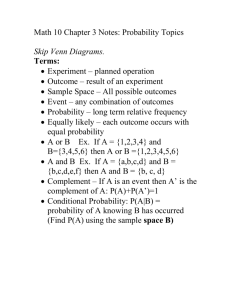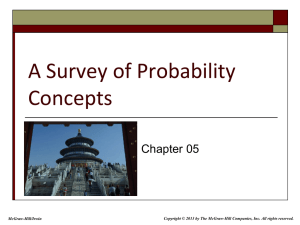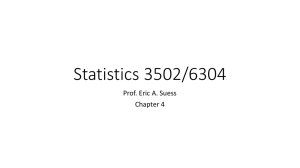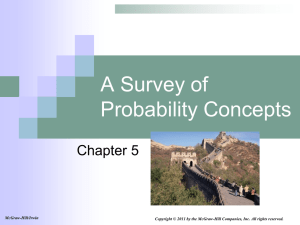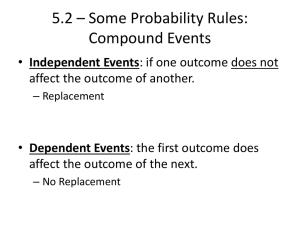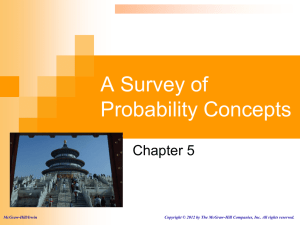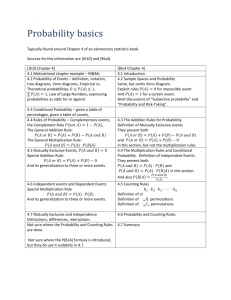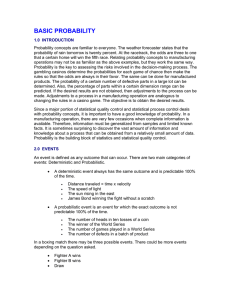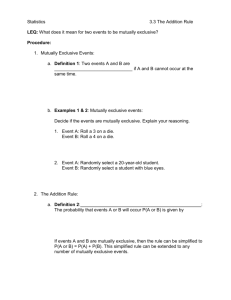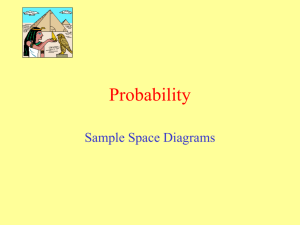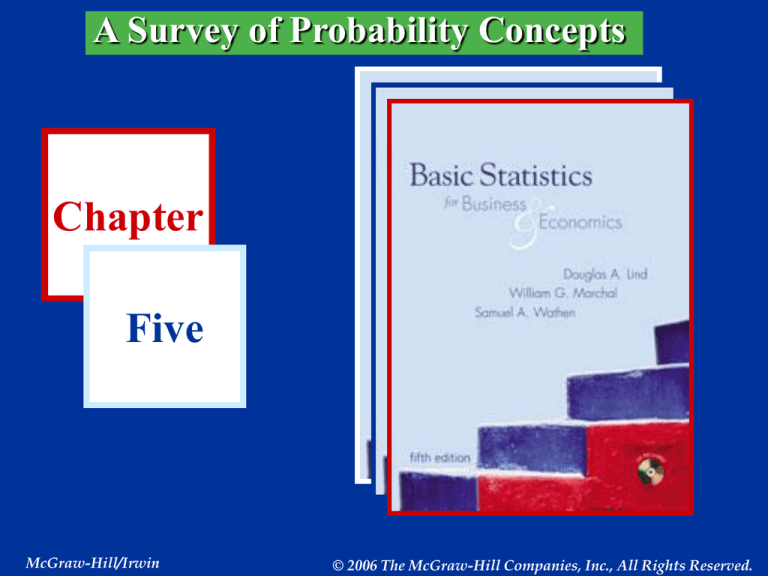
A Survey of Probability Concepts
Chapter
Five
McGraw-Hill/Irwin
© 2006 The McGraw-Hill Companies, Inc., All Rights Reserved.
Descriptive Statistics deals with what happened in the past.
Inferential Statistics deals with what may happen in the
future.
In studying about future events, we begin with the concept of
probability.
Expressed as a decimal between 0 and 1
Classical Probability
(assumes all outcomes are equally likely)
Probability of an event =
No of possible favorable outcomes
Total number of possible outcomes
Eg.
When you throw a die, what is P(Even) ?
Possible even numbers you can get are: 2, 4 & 6 (3 possible favorable outcomes)
Total possible outcomes are: 6 (ie. You can get 1,2,3…6)
So, P(Even) = 3/6 = 0.5
You can think of card games, lotteries as examples of classical probability.
Events are Mutually Exclusive if the occurrence of any one
event means that none of the others can occur at the same time.
Mutually exclusive: Rolling a 2 precludes rolling a 1, 3, 4, 5, 6
on the same roll.
Events are Collectively Exhaustive if at least one of the
outcomes must occur when an experiment is conducted.
If you throw a die, you must get either 1 or 2 or…6; ie. one of the
events must occur.
Rules for Computing Probabilities
(Memorize, ie. thru understanding!)
Complement rule:
P(A) = 1 – P(~A)
Special rule of addition: P(A or B) = P(A) + P(B)
General rule of addition: P(A or B) = P(A) + P(B) – P(A & B)
Special rule of multiplication: P(A and B) = P(A)xP(B)
General rule of multiplication: P(A and B) = P(A)xP(B|A)
or
= P(B)xP(A|B)
No. of combination from n objects taken r at a time:
nCr = n! / [r! (n-r)!]
Special Rule of Addition
If two events
A and B are mutually
exclusive, the
Probability of A or B equals
the sum of their respective
probabilities.
Checkout problem
#14 (a) on page 133
P(A or B) = P(A) + P(B)
The Complement rule using a Venn Diagram
P(A) + P(~A) = 1; thus, P(A) = 1 – P(~A)
Set of all possible outcomes
A
A subset of outcomes
~A
Checkout problem
#14 (b) on page 133
~A is called
the
complement
of A
The possible
remaining outcomes
The General Rule of
Addition
If A and B are two events that are not mutually
exclusive, then P(A or B) is given by the following
formula:
P(A or B) = P(A) + P(B) - P(A and B)
Joint probability
What is the probability a tourist visited Disney World OR Busch Gardens?
P(Disney OR Busch) = P(Disney) + P(Busch) – P(Disney AND Busch)
= .6
Venn diagram
+
.5
- .3
= .8
The area that is
‘double-counted’
must be subtracted.
This is what the
formula does.
Note:
If a tourist is allowed to visit only one park (ie mutually exclusive), then
P(Disney and Busch)=0. Then, the general rule becomes the special rule!
The Special Rule of Multiplication
This
rule is written:
P(A and B) = P(A) x P(B)
Events
A and B must be independent.
Independence means occurrence of one event has no effect
on the probability of the occurrence of the other.
Eg.
You toss 2 coins (or a coin two times). What is P(2 Heads)?
P(2Heads) = P(I coin is head) x P(II coin is also head)
Note that the outcome of one coin does not influence the other.
So, P(2 Heads) = .5 x .5 = .25
The General Rule of Multiplication
Events
A and B are not independent.
ie. One event has effect on the probability of the occurrence
of the other.
The rule is written:
P(A and B) = P(A)P(B|A)
P(A and B) = P(B)P(A|B)
or
Notes:
The probability of event A occurring given that the event B has occurred
is written P(A|B). It is called a Conditional probability.
If A and B are independent, P(A|B) = P(A). Think about a coin toss expt.
Whether you get a H or T is not dependent on the outcome of the prior
toss.
Question 1: If a student is selected at random, what is the
probability the student is a female?
P(F) = 400/100 (see Table in prior slide)
Question 2: What is the probability, the student is a female
accounting major?
P(F and A) = 110/1000 (again, see prior Table)
Question 3: Given that the student is a female, what is the
probability that she is an accounting major? ie Find P(A|F)
Major
We know from the General rule that
Accounting
P(F and A) = P(F) x P(A|F)
Finance
Re-arranging the formula,
Marketing
P(A|F) = P(F and A) / P(F)
Management
= [110/1000] / [400/1000]
Total
= .275
Male
170
Female
110
Total
280
120
100
220
160
70
230
150
120
270
600
400
1000
A Tree Diagram is useful for portraying conditional and joint
probabilities. It is particularly useful for analyzing business decisions
involving several stages.
Based on Self-Review 5-8 Page 140
Convenient
Visits
Yes
No
Total
Often
60
20
80
Occasio
nal
25
35
60
Never
5
50
55
90
105
195
1.00
A Combination is the number of ways to choose r
objects from a group of n objects where order does
not matter.
n!
nCr
r! (n r )!
where, n! = 1x2x3x ..... (n-2)x(n-1)xn
You want to select a committee of two out of three people. How many
ways are possible?
3C2
= 3! / [2! (3-2)!] = 3 ways
Say, these three people are: Mr.A, Mrs.B and Ms.C.
The three possible committee combinations are: A,B or A,C or B,C

